2017年1月广东省普通高中学业水平考试英语试卷
2017年1月广东省普通高中学业水平考试真题卷
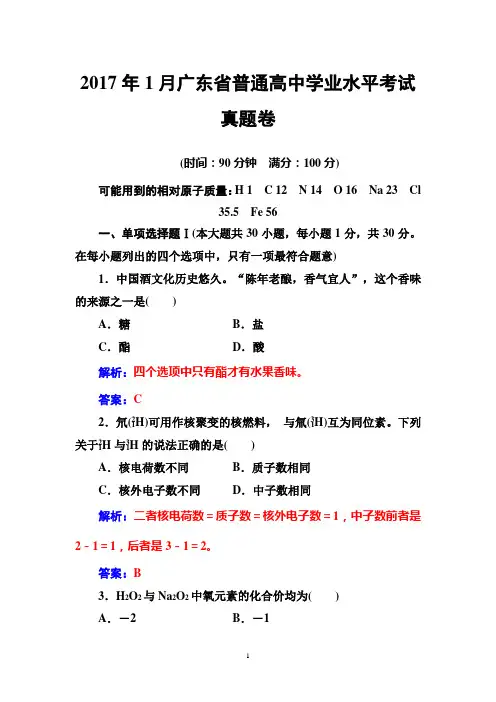
2017年1月广东省普通高中学业水平考试真题卷(时间:90分钟满分:100分)可能用到的相对原子质量:H 1 C 12N 14O 16Na 23Cl35.5Fe 56一、单项选择题Ⅰ(本大题共30小题,每小题1分,共30分。
在每小题列出的四个选项中,只有一项最符合题意)1.中国酒文化历史悠久。
“陈年老酿,香气宜人”,这个香味的来源之一是()A.糖B.盐C.酯D.酸解析:四个选项中只有酯才有水果香味。
答案:C2.氘(21H)可用作核聚变的核燃料,与氚(31H)互为同位素。
下列关于21H与31H的说法正确的是()A.核电荷数不同B.质子数相同C.核外电子数不同D.中子数相同解析:二者核电荷数=质子数=核外电子数=1,中子数前者是2-1=1,后者是3-1=2。
答案:B3.H2O2与Na2O2中氧元素的化合价均为()A.-2 B.-1C.+1 D.+2解析:两种物质中氧元素化合价都是-1。
答案:B4.氨气遇HCl气体时,有白烟出现,其反应为NH3+HCl===NH4Cl,该反应的反应类型是()A.分解反应B.置换反应C.化合反应D.复分解反应解析:该反应是两种反应物变成一种生成物,属于化合反应。
答案:C5.下列元素中,金属性最强的是()A.Na B.MgC.Al D.Si解析:它们是同周期元素,原子序数最小的金属性最强。
答案:A6.能使鲜花褪色的是()A.NaCl溶液B.CaCl2溶液C.新制氯水D.蔗糖溶液解析:新制氯水有强氧化性,氧化鲜花使之褪色。
答案:C7.牛奶和豆腐中含有丰富的钙,这里的“钙”应理解为() A.单质B.元素C.原子D.分子答案:B8.下列过程包含有化学变化的是()A.空气液化B.滴水穿石C.钢铁冶炼D.活字印刷解析:冶炼金属一般是将其化合物变成金属单质,有新物质生成,属于化学变化。
答案:C9.分类是学习和研究化学的一种重要方法。
下列分类合理的是()A.K2CO3和K2O都属于盐B.KOH和Na2CO3都属于碱C.H2SO4和HNO3都属于酸D.Na2O和Na2SiO3都属于氧化物解析:A中前者是酸后者是氧化物;B中前者是碱后者是盐;C 中两者都是酸;D中前者是氧化物后者是盐。
2017广东高考英语学业水平考试题(含答案)
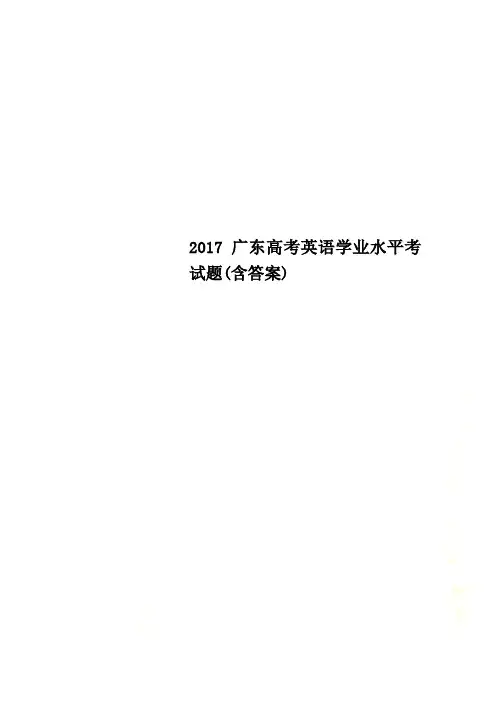
2017广东高考英语学业水平考试题(含答案)2017年广东省普通高中学业水平考试英语试题 (1)I.情景交际:本题共5小题,每小题2分。
阅读下列简短对话,从A、B、C和D中选出最佳答案,将对话补全。
1.—Where have you been recently?—I ________ in Hangzhou on business for a week last month.A. have beenB. wasC. had beenD. had gone2.—Excuse me, could you tell me the time, please?—Sorry, I don’t have a watch with me.—________.A. Thanks a lotB. What a pityC. I’m sorry to hear thatD. Thanks anyway3.—How do you like the curtains?—Well, I’m afraid they don’t ________ very well with the wallpaper.A. goB. matchC. suitD. fit4.—What do you think of the manager of your company?—Oh, he is ________ manager who’s pleasant to work with.It’s ________ pleasure to work with him.A. the; aB. a; aC. a; theD. 不填; a5.—It's wrong for a student to follow ________ his teachers say.—It’s true. I can’t agree ________ .A. no matter what; to muchB. whatever; muchC. no matter what; moreD. whatever; moreII.阅读理解本题共15小题,每小题2分阅读下列短文,掌握其大意,然后从每题所给的A、B、C和D项中选出最佳选项。
2017年广东省普通高中学业水平英语模拟试题(含答案)
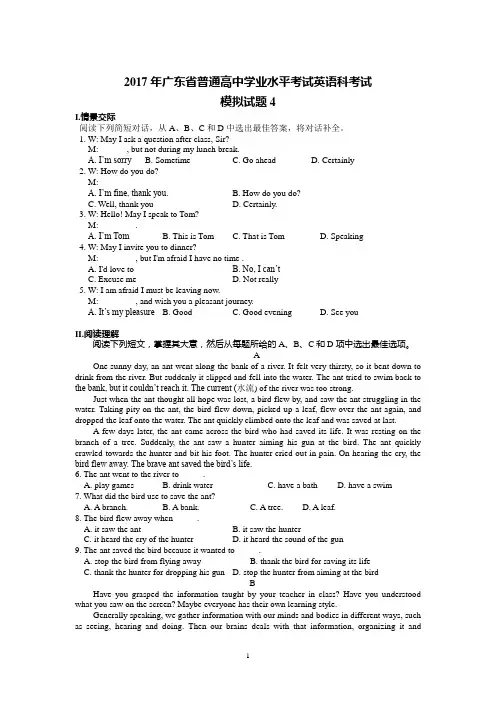
2017年广东省普通高中学业水平考试英语科考试模拟试题4I.情景交际阅读下列简短对话,从A、B、C和D中选出最佳答案,将对话补全。
1. W: May I ask a question after class, Sir?M: ______, but not during my lunch break.A. I’m sorryB. SometimeC. Go aheadD. Certainly2. W: How do you do?M: ______A. I’m fine, thank you.B. How do you do?C. Well, thank youD. Certainly.3. W: Hello! May I speak to Tom?M: ________.A. I’m TomB. This is TomC. That is TomD. Speaking4. W: May I invite you to dinner?M: ________, but I'm afraid I have no time .A. I'd love toB. No, I can’tC. Excuse meD. Not really5. W: I am afraid I must be leaving now.M: ________, and wish you a pleasant journey.A. It’s my pleasureB. GoodC. Good eveningD. See youII.阅读理解阅读下列短文,掌握其大意,然后从每题所给的A、B、C和D项中选出最佳选项。
AOne sunny day, an ant went along the bank of a river. It felt very thirsty, so it bent down to drink from the river. But suddenly it slipped and fell into the water. The ant tried to swim back to the bank, but it couldn’t reach it. The current (水流) of the river was too strong.Just when the ant thought all hope was lost, a bird flew by, and saw the ant struggling in the water. Taking pity on the ant, the bird flew down, picked up a leaf, flew over the ant again, and dropped the leaf onto the water. The ant quickly climbed onto the leaf and was saved at last.A few days later, the ant came across the bird who had saved its life. It was resting on the branch of a tree. Suddenly, the ant saw a hunter aiming his gun at the bird. The ant quickly crawled towards the hunter and bit his foot. The hunter cried out in pain. On hearing the cry, the bird flew away. The brave ant saved the bird’s life.6. The ant went to the river to _____.A. play gamesB. drink waterC. have a bathD. have a swim7. What did the bird use to save the ant?A. A branch.B. A bank.C. A tree.D. A leaf.8. The bird flew away when _____.A. it saw the antB. it saw the hunterC. it heard the cry of the hunterD. it heard the sound of the gun9. The ant saved the bird because it wanted to _____.A. stop the bird from flying awayB. thank the bird for saving its lifeC. thank the hunter for dropping his gunD. stop the hunter from aiming at the birdBHave you grasped the information taught by your teacher in class? Have you understood what you saw on the screen? Maybe everyone has their own learning style.Generally speaking, we gather information with our minds and bodies in different ways, such as seeing, hearing and doing. Then our brains deals with that information, organizing it andconnecting it to things we are already aware of. In other words, our brains will deal with the information in different ways. Sometimes we think in pictures or words. Sometimes we remember details or the big pictures.For different people, their learning styles are different too. One person may find it hard to make out the information in written forms but easy to know it immediately in an oral description. However, another person might find difficulties with the picture but the written message.Now scientists say there exist seven basic learning styles.·Linguistic: These people learn through listening, reading, speaking and writing.·Logical: These people learn with formula (公式) and principles (原理).·Visual: These people learn by seeing what they are studying.·Musical: These people learn well when information is presented through music.·Kinesthetic: These people learn from movement and physical activities.·Intrapersonal: These people learn best by linking new information directly with their own experiences.·Interpersonal: These people learn well by working with others.Therefore, if you know what learning style is your strength, you can balance your weakness, and get a more successful learning experience.10. From the passage, we know that our brains __________.A. deal with the information in different waysB. send out the information in the same wayC. organize information with our bodiesD. gather information in the same way11. A visual learner usually learns __________.A. through listening and speakingB. by seeing what he is learningC. from movement and physical activitiesD. by linking new information with his experience12. A musical learner will find it easy to learn __________.A. with formulas and principlesB. by working with othersC. through reading and writingD. through music he hears13. The purpose of the passage is to tell us to __________.A. learn more successfullyB. gather more informationC. understand more quicklyD. exchange information betterCZheng He was one of China’s most famous explorers. Towards the end of the fourteenth century, his fleet (舰队) sailed to countries far away.Zheng He had over 300 ships, some of which were over 150 meters long, and could carry up to 1,000 people. Besides, the ships carried gold, silver, silk, china and other treasures to give as gifts to the rulers of other countries. Some ships even had earth on board so that the sailors could grow their crops for food.On Zheng He’s first voyage, he set sail across the Indian Ocean. His fleet travelled many days far away from land. One day, they were hit by a storm. All the sailors thought the fleet was going to sink. Then a strange light appeared and after that, the storm passed. The strange light was probably electricity from the thunderstorm (雷雨), but the sailors in Zheng He’s fleet believed it was a sign of protection from the gods. With the belief, they were happy to follow Zheng He wherever he led them.Zheng He completed seven famous voyages between 1405 and 1433. He visited many countries in Asia and Africa. He brought back many gifts from the countries he visited, such as medicines, pearls (珍珠) and strange animals. The most famous of them were a giraffe and a zebra.In 28 years of travelling, Zheng He had managed to share the glory of China with many different countries. When he died in 1435, the stories of h is travels made him one of China’s most famous sailors.14. Some ships carried earth on board so that the sailors could __________.A. use it as a giftB. use it for exchangeC. plant trees for shadeD. grow their own crops for food15. The sailors were happy to follow Zheng He because of __________.A. a strange lightB. a heavy stormC. the belief in gods’ protecting themD. the electricity from the thunderstorm16.The most famous gifts Zheng He brought back were __________.A. a monkey and a tigerB. a giraffe and a zebraC. gold and silverD. medicines and pearls17. The best title of the passage can be __________.A. The Glory of ChinaB. Zheng He’s LifeC. Zheng He and His V oyagesD. China’s Most Famous ExplorersThis class takes place in the scienceA. TechnologyB. BiologyC. DramaD. Chemistry19. The underlined word ―Alternatively‖ is closest in meaning to ―_______‖.A. As another choiceB. For this reasonC. At the same timeD. In other words20. The information in the table is mainly for students to .A. organize hobby groupsB. do their homeworkC. choose teachersD. take classes III.完形填空阅读下面短文,掌握其大意,然后从各题所给的A、B、C和D项中选出最佳选项。
2017年1月广东省普通高中学业水平考试真题卷
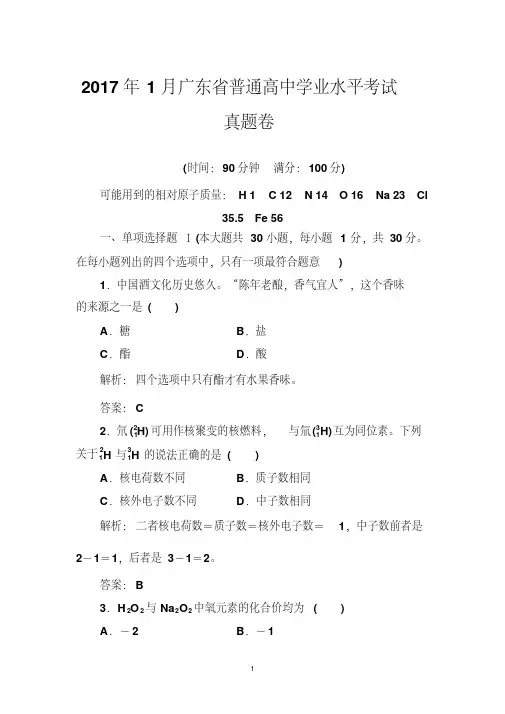
2017年1月广东省普通高中学业水平考试
真题卷
(时间:90分钟满分:100分)
可能用到的相对原子质量:H 1 C 12N 14O 16Na 23Cl
35.5Fe 56
一、单项选择题Ⅰ(本大题共30小题,每小题1分,共30分。
在每小题列出的四个选项中,只有一项最符合题意)
1.中国酒文化历史悠久。
“陈年老酿,香气宜人”,这个香味
的来源之一是()
A.糖B.盐
C.酯D.酸
解析:四个选项中只有酯才有水果香味。
答案:C
2.氘(21H)可用作核聚变的核燃料,与氚(31H)互为同位素。
下列关于21H与31H的说法正确的是()
A.核电荷数不同B.质子数相同
C.核外电子数不同D.中子数相同
解析:二者核电荷数=质子数=核外电子数=1,中子数前者是2-1=1,后者是3-1=2。
答案:B
3.H2O2与Na2O2中氧元素的化合价均为()
A.-2 B.-1
1。
2017年1月广东一般高中学业水平考试真题卷
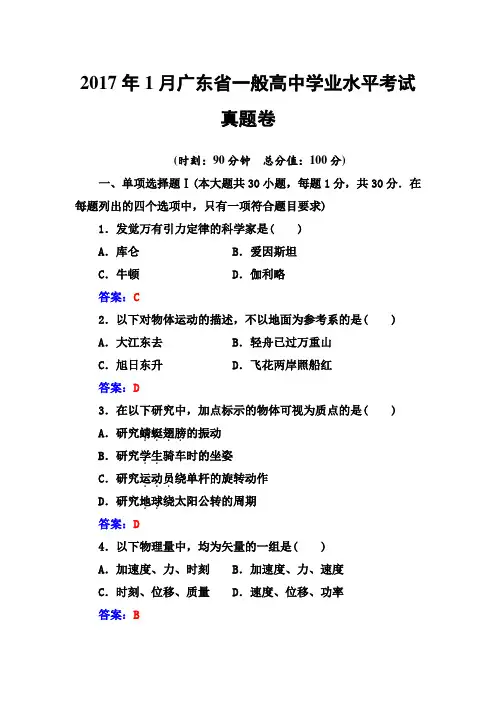
2017年1月广东省一般高中学业水平考试真题卷(时刻:90分钟总分值:100分)一、单项选择题Ⅰ(本大题共30小题,每题1分,共30分.在每题列出的四个选项中,只有一项符合题目要求)1.发觉万有引力定律的科学家是( )A.库仑B.爱因斯坦C.牛顿D.伽利略答案:C2.以下对物体运动的描述,不以地面为参考系的是( )A.大江东去B.轻舟已过万重山C.旭日东升D.飞花两岸照船红答案:D3.在以下研究中,加点标示的物体可视为质点的是( )A.研究蜻蜓翅膀....的振动B.研究学生..骑车时的坐姿C.研究运动员...绕单杆的旋转动作D.研究地球..绕太阳公转的周期答案:D4.以下物理量中,均为矢量的一组是( )A.加速度、力、时刻B.加速度、力、速度C.时刻、位移、质量D.速度、位移、功率答案:B5.物体做直线运动的v-t图象如下图.以下说法正确的选项是()A.物体做匀速直线运动B.物体做自由落体运动C.物体运动的加速度大小为1 m/s2D.物体运动的加速度大小为2 m/s2解析:由题图可知物体做加速度大小为1 m/s2的加速运动.答案:C6.做匀速圆周运动的质点,在Δt时刻内,转过的圆心角为Δθ.依照所给条件可求出质点的()A.角速度大小B.线速度大小C.向心加速度大小D.向心力大小答案:A7.在同一运动进程中,关于位移和路程的表述,以下说法正确的选项是()A.路程是矢量B.位移的大小老是等于路程C.位移确实是路程D.位移的大小小于或等于路程解析:当物体做单向直线运动时,位移的大小等于路程,其他情形位移大小小于路程.答案:D8.关于加速度和其他物理量之间的关系,以下说法正确的选项是()A.加速度的方向确实是速度的方向B.加速度的方向确实是位移的方向C.加速度减小时,速度必然减小D.加速度减小时,速度有可能增大答案:D9.甲、乙两物体均做直线运动,某时刻,甲的速度为4 m/s,加速度为-4 m/s2;乙的速度为3 m/s,加速度为2 m/s2,那么现在() A.甲、乙的速度方向相反B.甲的速度转变比乙的快C.甲的加速度大小比乙的小D.甲的速度转变比乙的慢解析:甲、乙两物体的速度方向相同,A错;加速度是反映速度转变快慢的物理量,甲的加速度大,速度转变得快,B对,C、D错.答案:B10.竖直悬挂的轻质弹簧,原长为8 cm,挂上10 N的物体后,当物体静止时,长度为10 cm(弹簧始终处于弹性限度内),那么此弹簧的劲度系数为()A.1 000 N/m B.500 N/mC.125 N/m D.100 N/m答案:B11.如下图,木箱放在传送装置的水平台阶上,在木箱随台阶向上做匀速直线运动的进程中,以下说法正确的选项是()A.木箱受到的合外力不为零B.木箱受到的支持力大于重力C.台阶对木箱没有摩擦力作用D.台阶对木箱的作使劲方向斜向上解析:木箱随台阶向上做匀速直线运动,受合力为零,即重力和支持力平稳,不受摩擦力作用,C对.答案:C12.一物体受到两个共点力的作用,力的大小别离为30 N、40 N,夹角为90°,那么合力大小为()A.35 N B.50 NC.60 N D.75 N答案:B13.如下图,重为65 N的物体在一个竖直向上拉力F=45 N的作用下,静止在水平桌面上.现在桌面对物体的支持力大小为()A.0 B.20 NC.45 N D.65 N解析:物体受重力、拉力和支持力作用,处于平稳状态,B对.答案:B14.关于物体的惯性,以下说法正确的选项是()A.物体在静止时才具有惯性B.物体在运动时才具有惯性C.物体在受外力作历时才具有惯性D.物体处于任何状态都具有惯性答案:D15.在以下情景中,属于有效利用离心现象的是()A.汽车拐弯时减速行驶B.给砂轮的外侧安装防护罩C.游客乘坐过山车时扣紧平安带D.运动员手持链球链条的一端加速旋转后松手答案:D16.一石块从枯井口自由下落,通过2 s抵达井底,忽略空气阻力,那么井深约为()A.10 m B.20 mC.25 m D.30 m答案:B17.如下图,物体在水平恒力F作用下沿水平地面做匀速直线运动,某时刻撤去F,那么现在物体受到的摩擦力()A.不变B.变成0C.方向改变D.大小减小答案:A18.如图所示,木箱在与水平方向成α角的拉力F作用下,沿水平地面向右移动了距离l,此进程中拉力F对木箱所做的功为()A.0 B.FlC.Fl cos αD.Fl sin α解析:由功的公式可知,C对.答案:C19.忽略空气阻力,以下物体在各自运动进程中,机械能守恒的是()A.电梯匀速下降B.木块沿粗糙斜面匀速下滑C.铅球出手后在空中运动D.重物被起重机吊起加速上升解析:电梯匀速下降,说明电梯受力平稳,并非是只有重力做功,A错;木块沿粗糙斜面匀速下滑,有摩擦力做功,B错;铅球出手后只有重力做功,机械能守恒,C对;D的重物机械能增加,D错.答案:C20.以下描述不属于经典力学范围的是()A.开普勒对行星运动规律的描述B.伽利略对落体运动规律的描述C.牛顿对物体低速运动规律的描述D.爱因斯坦对粒子接近光速运动规律的描述答案:D21.以下仪器工作时利用了静电现象的是()A.静电除尘器B.滑动变阻器C.变压器D.指南针答案:A22.关于静电场中的电场线,以下说法正确的选项是()A.电场线是一系列假想的闭合曲线B.电场线从负电荷动身,终止于正电荷C.在同一电场中电场线越密,电场强度越弱D.电场线上各点的切线方向表示该点的电场方向解析:电场线是假想的,但不闭合,A错;电场线从正电荷动身,终止于负电荷,B错;电场线越密,电场强度越强,C错.答案:D23.如下图,M,N为某电场中的两点,以下说法正确的选项是()A.该电场是匀强电场B.该电场是点电荷产生的电场C.M点的电场强度比N点的小D.M点的电场强度比N点的大答案:D24.在电路图中,用来表示电感器的字母及电路符号是()答案:C25.我国古代有“千里眼”的神话传奇,以下装置具有类似功能的是()A.雷达B.指南针C.录音机D.白炽灯答案:A26.某些大商场安装有自动门,当人靠近时它会自动打开.该装置利用的传感器是()A.红外线传感器B.气体传感器C.温度传感器D.声音传感器答案:A27.关于科学家所做的奉献,以下表述正确的选项是()A.法拉第发觉了电磁感应现象B.赫兹成立了电磁场理论C.安培发觉了电流的磁效应D.麦克斯韦验证了电磁波的存在解析:麦克斯成立了电磁场理论,奥斯特发觉了电流的磁效应,赫兹验证了电磁波的存在,B、C、D均错.答案:A28.如下图,阴极射线管水平放在蹄形磁铁的N、S两极间,射线管的阴极A接直流高压电源负极,阳极B接正极,那么管内电子束的偏转方向()A.向上B.向下C.向N极D.向S极答案:B29.以下关于磁场和磁感线的描述正确的选项是()A.两条磁感线能够相交B.磁感线是真实存在的曲线C.两条磁感线之间不存在磁场D.磁感线是为了形象地描述磁场而引入的假想曲线解析:两条磁感线不相交,A错;磁感线是假想曲线,B错,D 对;磁感线存在的空间有磁场,C错.答案:D30.以下能源中,属于不污染环境且比较经济的能源是()A.煤B.风能C.石油D.天然气答案:B二、单项选择题Ⅱ(本大题共20小题,每题2分,共40分.在每题列出的四个选项中,只有一项符合题目要求)31.以下图象能反映物体做匀加速直线运动的是()答案:D32.甲、乙两物体同时从同一地址沿同一方向做直线运动,它们运动的v-t图象如下图.以下说法正确的选项是()A.0~4 s甲比乙运动慢B.0~4 s甲比乙运动快C.第2 s末甲、乙速度相同D.第4 s末甲、乙速度相同解析:前2 s甲比乙运动快,后2 s甲比乙运动慢,A、B错;第2 s末甲、乙速度相同,C对,D错.答案:C33.乘客站在电梯里,当电梯以1 m/s2的加速度加速下降时,乘客对电梯的压力()A.等于零B.小于乘客受到的重力C.等于乘客受到的重力D.大于乘客受到的重力解析:电梯加速下降,乘客失重,B对.答案:B34.如下图,质量为m的物体静止在倾角为θ的固定斜面上.以下说法正确的选项是()A.斜面对物体的支持力大小等于mg cos θB.斜面对物体的支持力大小等于mg sin θC.斜面对物体的支持力方向竖直向下D.斜面对物体的支持力方向竖直向上解析:斜面对物体的支持力方向垂直斜面向上,大小为mg cos θ,A对,其余均错.答案:A35.如下图,在水平压力作用下,物体紧靠竖直墙壁维持静止.以下说法正确的选项是()A.物体受到的重力与静摩擦力大小相等B.水平压力F与墙面对物体的弹力大小不相等C.物体受到的重力与静摩擦力是作使劲与反作使劲D.水平压力F与墙面对物体的弹力是作使劲与反作使劲解析:物体受到的重力与静摩擦力大小相等,A对;水平压力F 与墙面对物体的弹力大小相等,B错;水平压力F与墙面对物体的弹力及重力与静摩擦力都是一对平稳力,C、D错.答案:A36.国际单位制由大体单位、辅助单位和导出单位组成.以下物理量单位属于大体单位的是()A.N B.mC.m/s D.m/s2答案:B37.如下图,质量为m的物块随水平转盘绕竖直固定轴做匀速圆周运动,角速度为ω,物块到轴的距离为l,那么物块受到的摩擦力大小为()A.ml2ω2B.mlωC.ml2ωD.mlω2解析:由向心力公式可知,D对.答案:D38.两球都可视为质点,它们之间的万有引力大小为F,假设两球间的距离增加到原先的3倍,那么它们之间的万有引力大小为()F FF F答案:C39.如下图,人造卫星M、N别离绕地球做匀速圆周运动,关于它们的线速度v,角速度ω,向心加速度a和周期T的大小比较,关系正确的选项是()A.v M<v N B.a M<a NC.ωM>ωN D.T M>T N答案:C40.如下图,两个高度相同的固定斜面,倾角为30°、45°,一木块别离从两斜面的顶端下滑至底端,重力对木块所做的功为W1、W2,以下关系正确的选项是()A.W1=W2B.W1=2W2C.W1=3W2D.W1=4W2解析:重力做功与途径无关,只由初末位置的高度差决定,A对.答案:A41.起重机用4 s的时刻把重为2×104 N的货物匀速提升10 m,那么该起重机对货物做功的功率为()A.2×103 W B.8×102 WC.5×104 W D.8×104 W解析:货物匀速上升,由受力分析可知:拉力F=G=2×104 N,货物的速度v=m/s,P=F v=2×104 N×m/s=5×104 W,C对.答案:C42.如图是在“研究匀变速直线运动”的实验顶用打点计时器打出的纸带,纸带上的点记录了物体运动的信息.在纸带上选择3个计数点0、一、2,相邻两点间的时刻距离均为s,距离如下图,那么打下计数点1时,物体的瞬时速度大小为()A.m/s B.m/sC.m/s D.m/s答案:B43.用如下图的装置研究静摩擦力,慢慢增大弹簧测力计的水平拉力,当拉力小于10 N时,物体维持静止;等于10 N时,物体恰好开始运动.以下说法正确的选项是()A.物体与桌面间的最大静摩擦力大小为10 NB.物体与桌面间的静摩擦力大小和水平拉力大小无关C.当弹簧测力计的示数为15 N时,物体仍受到静摩擦力作用D.当弹簧测力计的示数为5 N时,物体受到的静摩擦力大小为10 N解析:由最大静摩擦力的概念知,A对;当物体没拉动时,静摩擦力大小等于水平拉力大小,B、D错;当弹簧测力计的示数为15 N 时,物体被拉动,受滑动摩擦力,C错.答案:A44.在“验证牛顿运动定律”的实验中,平稳摩擦力后,维持小车质量不变,改变小桶中沙的质量,并测出小桶和沙的总质量,算出小车受到的合外力大小F,同时求出小车的加速度大小a,按正确方式多次重复以上步骤(小桶和沙的总质量远小于小车的质量).以下图象能正确反映aF关系的是()答案:A45.如下图,绝缘细线上端固定,下端悬挂一轻质带电小球N,当带同种电荷的金属球M固定在N近旁的绝缘支架上时,悬挂N的细线与竖直方向的夹角为θ,那么以下说法正确的选项是()A .仅将M 的电荷量增大,θ不变B .仅将M 的电荷量增大,θ变小C .仅将支架沿水平地面移近N ,θ变小D .仅将支架沿水平地面移近N ,θ变大解析:由库仑定律知:F =k q M q N r2;对N 球受力分析知,F =mg tan θ;可见M 的电荷量增大,θ变大,A 、B 错;将支架沿水平地面移近N ,θ变大,C 错,D 对.答案:D46.两个相同的带电金属小球,带电量别离为+3q 和+7q ,小球半径远小于两球心的距离r .将它们接触后放回原处,那么现在的静电力大小为( )A .k 10q 2r2 B .k 16q 2r 2 C .k 21q 2r 2 D .k 25q 2r2 解析:两相同球接触后电量迅速转移,分开时各自带电量+5q ,由库仑定律知,D 对.答案:D47.如下图,一根通电直导线放置在水平向右的匀强磁场B 中,电流方向垂直纸面向里,那么直导线受到的安培力方向是( )A .垂直纸面向里B .垂直纸面向外C.竖直向下D.竖直向上解析:由左手定那么知,C对.答案:C48.如下图,小磁针放在水平通电直导线的正下方,当小磁针静止时,N极的指向是()A.水平向右B.水平向左C.垂直纸面向里D.垂直纸面向外解析:由安培定那么知,直导线的下方磁场方向是垂直纸面向外,D对.答案:D49.如下图,在范围足够大的匀强磁场B中有一矩形线圈MNPQ,线圈平面平行于磁场方向.做以下运动时,通过线圈的磁通量会发生转变的是()A.线圈绕MQ边转动B.线圈绕MN边转动C.线圈向上平移D.线圈向右平移解析:线圈绕MQ边转动,磁通量始终为零,A错;线圈绕MN 边转动,磁通量不断转变,B对;线圈向上平移及线圈向右平移,磁通量始终为零,C、D错.答案:B50.在如下图的电路中,当变压器的原线圈接入电压u时,副线圈中小灯泡开始发光,那么电压u随时刻t转变的关系图象不可能的是()答案:B三、多项选择题(本大题共10小题,每题3分,共30分.在每题列出的四个选项中,至少有2个选项是符合题目要求的,全数选对得3分,少选且正确得1分,未选、错选不得分)51.在平直轨道上匀速行驶的列车中,乘客在某高度处无初速度释放一小球.不计空气阻力,以下说法正确的有() A.该乘客观看到小球做匀速直线运动B.该乘客观看到小球做自由落体运动C.站在地面的人观看到小球做曲线运动D.站在地面的人观看到小球做匀速直线运动解析:小球离手前与车有相同的水平速度,故小球做平抛运动,但相对乘客做自由落体运动,B、C对.答案:BC52.以下图是自行车部份结构示用意,M是大齿轮边缘上一点,N是小齿轮边缘上一点,P是车轮上一点.当自行车正常行驶时,以下说法正确的有()A.M、N两点角速度大小相等B.M、N两点线速度大小相等C.N、P两点角速度大小相等D.N、P两点线速度大小相等解析:大小轮是靠链条传动,M、N两点线速度大小相等,A错,B对;N、P两点是共轴转动,角速度大小相等,C对,D错.答案:BC53.如下图,实线为某质点平抛运动轨迹的一部份,s1表示M、N两点间水平距离,s2表示N、P两点间水平距离,且s1=s2.以下说法正确的有()A.质点在N、P两点的水平分速度一样B.质点在M、N两点的竖直分速度一样C.质点从M点运动到N点的时刻等于从N点到P点的时刻D.质点从M点运动到N点的时刻大于从N点到P点的时刻解析:做平抛运动的物体水平方向的速度始终相等,A对;竖直方向速度不断增大,B错;水平方向匀速运动,且s1=s2,故有质点从M点运动到N点的时刻等于从N点到P点的时刻,C对,D错.答案:AC54.如下图,一木块从固定的粗糙斜面顶端沿斜面加速下滑,在下滑进程中,以下说法正确的有()A.重力对木块做正功B.重力对木块做负功C.摩擦力对木块做正功D.摩擦力对木块做负功解析:因为重力的方向与位移的方向的夹角小于90°,重力对木块做正功,A对,B错;物体受滑动摩擦力的方向沿斜面向上,摩擦力方向与位移的方向的夹角大于90°,摩擦力对木块做负功,C 错,D对.答案:AD55.将两个内壁滑腻、半径不同的半球形碗,固定在如下图的水平台阶上,碗口在同一水平面上,取此水平面为参考平面.将两个相同的小球,别离从两个碗的边缘处无初速释放,当它们运动到各自的最低点时()A.两小球的动能相等B.两小球的动能不相等C.两小球的重力势能相等D.两小球的机械能相等解析:按动能定理,因重力做功不等,最低点时动能不等,A错,B对;因最低点的高度不同,两小球的重力势能也不相等,C错;但两球的机械能始终守恒,D对.答案:BD56.以下关于电性能量转换的描述正确的有()A.发电性能够把机械能转换成电能B.电动性能够把电能转换成机械能C.电动性能够把机械能转换成电能D.电机可使电能和其他形式的能彼此转换解析:发电性能够把机械能转换成电能,A对;电动性能够把电能转换成机械能,B对,C错;电机可使电能和其他形式的能彼此转换,D对.答案:ABD57.在以下匀强磁场B中,带电粒子受到的洛伦兹力为F,则F 的方向正确的有()解析:依照左手定那么,A对,C对;B中带电粒子所受洛伦兹力垂直纸面向里,B错;D中带电粒子所受洛伦兹力垂直纸面向外,D错.答案:AC58.以下电器在利用进程中,利用了电磁波的有()A.电熨斗B.风扇C.电视机D.收音机答案:CD59.在家庭平安用电中,以下做法不正确的有()A.袒露的电线缠绕在木板上B.洗衣机的金属外壳接地线C.不同材质的电线相互缠绕在一路D.同一个插座上插满了各类大功率电器答案:ACD60.以下图是一种简易风速仪的示用意.当水平方向有风吹来时,风速仪的外接电流计就有示数.以下说法正确的有()A.该风速仪工作时应用了电磁感应原理B.该风速仪工作时应用了电流的磁效应C.风速越大,电流计的示数越大D.风速越大,电流计的示数越小解析:当风速大时,轴转动得越快,线圈中的磁通量的转变越快,电流越大,A、C对.答案:AC。
2017高二水平测英语试题
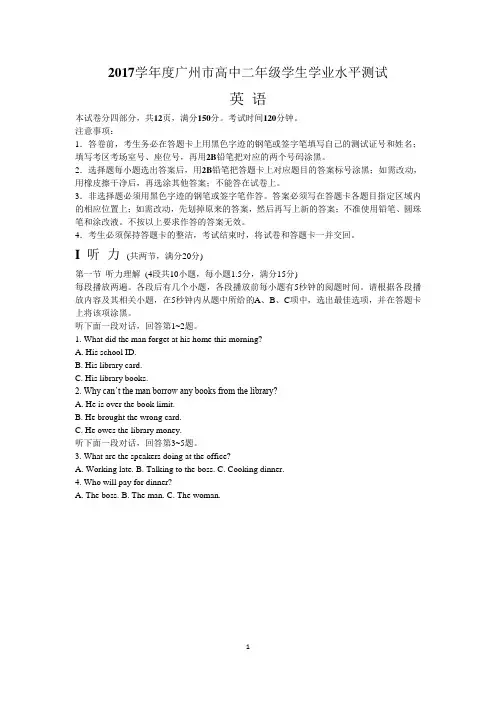
2017学年度广州市高中二年级学生学业水平测试英语本试卷分四部分,共12页,满分150分。
考试时间120分钟。
注意事项:1.答卷前,考生务必在答题卡上用黑色字迹的钢笔或签字笔填写自己的测试证号和姓名;填写考区考场室号、座位号,再用2B铅笔把对应的两个号码涂黑。
2.选择题每小题选出答案后,用2B铅笔把答题卡上对应题目的答案标号涂黑;如需改动,用橡皮擦干净后,再选涂其他答案;不能答在试卷上。
3.非选择题必须用黑色字迹的钢笔或签字笔作答。
答案必须写在答题卡各题目指定区域内的相应位置上;如需改动,先划掉原来的答案,然后再写上新的答案;不准使用铅笔、圆珠笔和涂改液。
不按以上要求作答的答案无效。
4.考生必须保持答题卡的整洁,考试结束时,将试卷和答题卡一并交回。
I 听力(共两节,满分20分)第一节听力理解(4段共10小题,每小题1.5分,满分15分)每段播放两遍。
各段后有几个小题,各段播放前每小题有5秒钟的阅题时间。
请根据各段播放内容及其相关小题,在5秒钟内从题中所给的A、B、C项中,选出最佳选项,并在答题卡上将该项涂黑。
听下面一段对话,回答第1~2题。
1. What did the man forget at his home this morning?A. His school ID.B. His library card.C. His library books.2. Why can’t the man borrow any books from the library?A. He is over the book limit.B. He brought the wrong card.C. He owes the library money.听下面一段对话,回答第3~5题。
3. What are the speakers doing at the office?A. Working late.B. Talking to the boss.C. Cooking dinner.4. Who will pay for dinner?A. The boss.B. The man.C. The woman.5. Which part of the woman’s order is wrong?A. The rice.B. The egg.C. The duck.听下面一段对话,回答第6~7题。
2017广东高考英语学业水平考试题(含答案)
2017 年广东省普通高中学业水平考试英语试题(1)I.情景交际:本题共 5 小题,每小题 2 分。
阅读下列简短对话,从A、 B、C 和 D 中选出最佳答案,将对话补全。
1.— Where have you been recently?— I ________ in Hangzhou on business for a week last month.A. have beenB. wasC. had beenD. had gone2.— Excuse me, could you tell me the time, please?— Sorry, I don ?t have a watch with me.— ________.A. Thanks a lotB. What a pityC. I?m sorry to hear thatD. Thanks anyway3.—How do you like the curtains?— Well, I ?m afraid they don ?t ________ very well with the wallpaper.A. goB. matchC. suitD. fit 4.— What do you think ofthe manager of your company?— Oh, he is ________ manager who ?s pleasant to workwith. It?s ________ pleasure to work with him.A. the; aB. a; aC. a; theD. 不填 ; a 5.— It's wrong for astudent to follow ________ his teachers say.— It?s true. I can?t agree ________ .A. no matter what; to muchB. whatever; muchC. no matter what; moreD. whatever; moreII. 阅读理解本题共 15 小题,每小题 2 分A、 B、C 和 D 项中选出最佳选项。
广东省普通高中学业水平考试参考试题含答案
广东省普通高中学业水平考试参考试题含答案一、语文试题01.下面各词语汉字注音不正确的一项是?A. 社会(shè huì)B. 恒河(héng hé)C. 发育(fà yù)D. 桂冠(guì guàn)02.下列词语中,哪一组词的读音完全相同?A. 零碎、举报B. 原油、泉水C. 推翻、摇篮D. 环游、击毙03.下列词语中,哪一组词的字形完全相同?A. 情感、爱恨B. 优秀、卓越C. 强势、强壮D. 美观、雅致04.下列词语中,哪一组的意义不同于其他选项?A. 情绪、心情B. 车辆、交通C. 争夺、竞争D. 行为、行径05.古人有云:“士可杀不可辱,妇人可辱不可杀。
”这句话的意思是:A. 士人宁愿受辱也不愿杀人B. 妇女感情脆弱,承受不了杀人之痛C. 古代士人注重面子,不在乎生命D. 古代妇女有时比男人更重视荣誉......二、数学试题01.已知函数f(x)的定义域为[0, 4],对于x∈[0, 4],f(x)的值为|x - 2|+ k,若当x从0增大到4时,f(x)的值从k增大到2k,求k的取值范围。
02.某工厂生产某种产品,以X万元投资,每个月盈利Y万元。
已知当X=30万元时,Y=25万元;当X=45万元时,Y=36万元。
根据已知数据,求:(1) X和Y的线性函数关系;(2) 当X=80万元时,预计的盈利。
03.设函数f(x) = ax + b,其中a,b是常数,且f(1) = 4,f(2) = 8。
求f(3)的值。
04.若a+b=3,a^2+b^2=7,求ab的值。
......三、英语试题Section A: Grammar and Vocabulary01. Could you please turn _____ the radio? I can't concentrate on my work.A. downB. offC. upD. on02. My brother is _____ engineer. He works for a famous company inthe city.A. aB. anC. theD. -03. The students _____ to the library to borrow some books for their research.A. wentB. goC. goesD. are going04. I have been learning Chinese _____ two years.A. sinceB. forC. inD. until......Section B: Reading ComprehensionPassage 1In ancient times, people used to guess the future by observing animal behaviors. They believed that animals had powers to predict the weather, natural disasters, and even human fortunes. For example, the ancient Chinese believed that the cry of a magpie announced the arrival of a guest or signaled that good news was on the way. In modern times, however, people have learned to rely on scientific methods to predict and understand the world.......Passage 2Basketball is a popular sport that is played all over the world. It was invented in December 1891 by James Naismith, a Canadian physical education instructor. Naismith wanted to create a game that could be played indoors during the winter months. He came up with the idea of attaching peach baskets to the railing of the gymnasium balcony, and the players would try to throw a soccer ball into the basket. The first game was playedwith nine players on each team, using the basic rules that are still followed today.......以上是广东省普通高中学业水平考试的部分参考试题,试题的完整答案和详细解析请参阅考试指导书或相关教材。
2017年高考英语试题(广东版)
2017年高考英语试题(广东版)2017年普通高等学校招生全国统一考试 (新课标I )英语 第二部分 阅读理解(共两节,满分40分)第一节(共15小题;每小题2分,满分30分)阅读下列短文,从每题所给的 A 、B 、C 和D 四个选 项中,选出最佳选项,并在答题卡上将该项涂黑。
APacific Scie nee Cen ter GuideVisit Pacific Scienee Center ' s StoreDon ' t forget to stop by Pacific Scienee Center s while you are here to pick up a won derful scie neeactivity or souve nir to remember your visit. The store islocated ( 位 于)upstairs in Building 3 right next to theLaster Dome.♦ Hun gryOur exhibits will feed your mind, but what about yourbody? Our caf offers a complete menu of lunch and sn ackopti on s, i n additi on to seas onal specials. The caflocated upstairs in Building 1 and is open daily until one hourbefore Pacific Scie nee Cen ter closes. ♦ Ren tal In formati onStoreis Lockers are availableyour visit. The lockers areInformation Desk and into store any belongs during located in Buildi ng 1 n ear the Building 3. Pushchairs andwheelchairs are available to rent at the In formati on Desk第2页and Denny Way entran ce. ID required.♦Support Pacific Scie nee Cen terSince 1962 Pacific Scie nee Cen ter has bee n in spiri ng a passion(热情)for discovery and lifelong learning in scienee, math and tech no logy. Today Pacific Scie nee Cen ter serves more than 1.3 million people a year and beings inquiry based scienee education to classrooms and community events all over Washington State. It ' an amazing accomplishment and one we cannot achieve without generous support from individuals,corporations, andother social orga ni zati ons. Visit pacificscie ncece to find various ways you can support Pacific Scie nee Cen ter.21. Where can you buy a souve nir at Scie nee Cen ter?A. In Building 1.B. In Building 3.C. At the last Denn y.D. At the Denny Wayentran ce.22. What does Pacific Scie nee Cen ter do for schools?A. Train Scienee teachers.B. Distributescie nee books.C. In spire scie ntific research.D. Takescie nee to the classroom.23. What is the purpose of the last part of the text?A. To en courage don ati ons.B. To advertise coming eve nts.C. To introduce special exhibits.D. To tell about thecenter ' history.------------------------------- BI work with Volunteers for Wildlife, a rescue and education organization at Bailey Arboretum in Locust Valley. Tryi ng to help injured, displaced or sick creatures can be heartbreaking; survival is never certain. However, whe n it works, it is simply beautiful.I got a rescue call from a woma n in Mutt on tow n. She had found a young owl(猫头鹰)on the ground. When I arrived, I saw a 2-to 3-week-old owl. It had already been placed in a carrier for safety.I examined the chick(雏鸟)and it seemed fine. If I could locate the n est, I might have bee n able to put it back, but no luck. My n ext work was to con struct a n est and an chor it in a tree.The homeowner was very helpful. A wire basket was found. I put some pine branches into the basket to make this nest safe and comfortable. I placed the chick in the n est, and it quickly calmed dow n.Now all that was n eeded were the pare nts, but they were absent. I gave the homeowner a recording of the hungerscreams of owl chicks. These advertise the presenee of chicks to adults; they might also encourage our chick to start calling as well. I gave the owner as much information as possible and headed home to see what news the might bring.A n ervous ni ght to be sure, but sometimes the spiritsnature smile on us all! The homeow ner called to saythat the pare nts had resp on ded to the recordi ngs. I drove over and saw the chick in the nest looking healthy and active. And it was accompa nied in the n est by the greatest sight of all — LUNCH ! The parents had done their duty and would probably continue to do so.24. W hat is unavoidable in the author ' rescue work according to paragraph 1?A. Efforts made in vain.Getting injured in his work.C. Feeli ng un certa in about his future.Creatures forced out of their homes.25. W hy was the author called to Mutto ntow n?A. To rescue a woma n.To take care of a woma n.C. To look at a baby owl.To cure a young owl.ni ght ofB. D. B. D.26. What made the chick calm dow n?A. A new n est.B. Some food.C.A recordi ng. D. Its pare nts.27. How would the author feel about the outcome of the event?A. It ' u s expected.B. It ' beautiful.C. It ' h s morous.D. It ' d S couraging.CSome of the world ' most famous musicians recently gathered in Paris and New Orleans to celebrate the first annual International Jazz Day. UNESCO( United Nations Educati on al, Scie ntific and Cultural Orga ni zati on)recently set April 30 as a day to raise awareness of jazz music, its significanee, and its potential as a unifying( 联合) voice across cultures.Despite the celebrati ons, though, in the U.S. the jazz audienee continues to shrink and grow older, and the music has failed to conn ect with youn ger gen erati ons.It ' Jason Moran' sjob to help change that. As the Kennedy Center ' s artistic adviser for jazz, Moran hopes to widen the audienee for jazz, make the music more accessible, and preserve its history and culture.“ Jazzseems like it ' not really a part of the American appetite, Moran tells National Public Radio ' Bgporter Neal Conan. “ Whatl ' nhoping to accomplish is that my gen erati on and youn ger start to recon sider and un dersta nd that jazz is not black and write anymore. It ' s acti and it ' s actually digital. ”Moran says one of the problems with jazz today is that the en terta inment aspect of the music has bee n lost. music can ' t be presented today the way it was in 1908 or 1958. It has to continue to move, because the way the world works is not the same, ” says Moran.Last year, Moran worked on a project that arranged Fats Waller ' s music for a dance party, “ Just to kin(it back in the mind that Waller is dance music as much as it is con cert music, ” says Moran. “ For me, it ' the recontextualization. In music, where does the emotionC情感)lie? Are we, as huma ns, ga ining any in sights (感悟)on how to talk about ourselves and how something as abstract as a Charlie Parker record gets us into a dialogue about our emoti ons and our thoughts? Sometimes we lose sight that the music has a wider co ntext, ” says Moran, “ S I want to con ti nuethose dialogues. Those are the thi ngs I want to foster. ”28. Why did UNESCO set April 30 as International JazzDay?A. To remember the birth of jazz.B. To protect cultural diversity.C . To encourage people to study music.D . To recog nize the value of jazz.29. What does the underlined word “ that ” inParagraplrefer to?A . Jazz becoming more accessible.B . The producti on of jazz grow ing faster.C. Jazz being less popular with the young. D . The jazz audie nee becom ing larger.30. What can we infer about Moran ' s opinion on jazz?A. It will disappear gradually.B. It rema ins blackand white.C. It should keep up with the times. D . It changes every 50 years.31. Which of the following can be the best title for the text?A. Exploring the Future of jazz.B. The Rise andFall of jazz.C. The Story of a jazz Musician. D . Celebrating theJazz Day.DA build-it-yourself solar still (蒸馏器)is one of thebest ways to obtain drinking water in areas where the liquid is not readily available. Developed by two doctors in the U.S. Department of Agriculture, it ' s an excellen,collector. Unfortunately, you must carry the necessary equipment with you, since it ' as but impossible to find n atural substitutes. The only comp onents required, though, are a 5 '5' sheet of clear or slightly milky plastic, six feetof plastic tube, and a container ——perhaps just a drinking cup —to catch the water. These pieces can be folded into a n eat little pack and faste ned on your belt.To con struct a work ing still, use a sharp stick or rock to dig a hole four feet across and three feet deep. Try to make the hole in a damp area to in crease the water catcher ' productivity. Place your cup in the deepest part of the hole. The n lay the tube in place so that one end rests all the way in the cup and the rest of the line runs up —and out —the side of the hole.Next, cover the hole with the plastic sheet, securing the edgesof the plastic with dirt and weighting the sheet ' s center down with a rock. The plastic should now form a cone(圆锥体)with 45-degree-angled sides. The low point of the sheet must be cen tered directly over, and no more tha n three in ches above, the cup.The solar still works by creating a greenhouse under the plastic. Ground water evaporates (蒸发)and collects on the sheet until small drops of water form, run down the material, and fall off into the cup. When the container is full, you can suck the refreshment out through the tube, and won ' t havte break down the still every time you need a drink.32. What do we know about the solar still equipme nt from the first paragraph?A. It ' s delicate.B. It ' s expensive.C. It ' s complex.D. It ' s portable33. What does the underlined ph rase “ the water catcher paragraph 2 refer to?A. The tubeB. The stillC. The holeD. The cupsolar 34. What ' the last step of con struct ing a worki ngstill?A. Dig a hole of a certa in sizeB. Put thecup in placeC. Weight the sheet ' center downD. Cover the hole with the plastic sheet35. W hen a solar still works, drops of water come into thecup form _________holeA. the plastic tubeB. outside the D. ben eath theC. the ope n air sheet第二节(共5小题;每小题2分,满分10分) 根据短文内容,从短文后的选项中选出能填入学科 空白处的最佳选项。
广东广州市普通高中2017-2018学年高一英语1月月考试题
上学期高一英语1月月考试题05共150分。
时间为120分钟。
第 I 卷(选择题共95分)第一部分:英语知识运用(共三节,满分50分)第一节:语音知识(共5小题,每小题1分,共5分)从A、 B 、C 、D四个选项中,找出其划线部分与所给单词划线部分读音相同的选项。
1. nativeA. adviceB. grammarC. baseD. master(4)breatheA. clothesB. healthC. eighthD. tenth3. refuseA. questionB. stupidC. trueD. Trunk4.extraA. exceptB. explainC. exhibitionD. exam5. oceanA. spaceB. poisonC. nationD. percent第二节:语法和词汇知识(共15小题;每小题1分,满分15分)从A、B、C、D四个选项中,选出可以填入空白处的最佳选项。
6. -- Have you moved into your new house?-- Not yet. The rooms _______.A.are paintingB. have been paintedC. are being paintedD. have painted7.She has decided _______ as a volunteer teacher in a small village because she enjoys _______ challenges.A. to work, to meetB. to work, meetingC. working, meetingD. working, to meet8. Mary left London five years ago and I _______ her since then.A. don’t seeB. didn’t seeC. hadn’t seenD. haven’t seen9. Put on your coat, ____________you will catch a cold..A. soB. butC. andD. or10. The volleyball match _______ if it rains tomorrow.A. will put offB. will be put offC. is put offD. puts off11. —I’m going to Thailand this summer holiday.—____A. Have a nice trip!B. Write to me.C. Take care!D. When will you go?12. We’re just received the worst news ____ many people have caught the bad disease .A.in whichB. whenC. thatD. what13.Thank you for all your hard work last week. I don’t think we _________ it without you.A. can manageB. could have managedC. could manageD. can have managed14. Seeing that he was so seriously ill, I insisted that he _________ to hospital at once.A. was sentB. be sentC. will be sentD. had been sent15. -- Do you know our town at all?-- No, this ________ the first time I _________ here.A. was; has comeB. is; comeC. is; had comeD. is; have come16. -- I’m not sure if we’ll have a picnic this weekend.-- It all ________ the weather.A. takes part inB. depends onC. comes toD. puts up17. The number of people who _________ cars _________ increasing in China.A. owns, areB. owns, isC. own, isD. own are18. Alice trusts you, only you can _________ her to give up the foolish idea.A. tryB. attractC. temptD. persuade19. I was about to go shopping ________ it began to rain.A. whileB. asC. whenD. Though20. Nowadays, old people like to live ________ there is no noise and crowds.A. whereB. whichC. whatD. that第三节:完形填空(共20小题,每小题1.5分,满分30分)阅读下面短文,从短文后各题所给的四个选项(A、B、C、D)中,选出可以填入空白处的最佳选项。
- 1、下载文档前请自行甄别文档内容的完整性,平台不提供额外的编辑、内容补充、找答案等附加服务。
- 2、"仅部分预览"的文档,不可在线预览部分如存在完整性等问题,可反馈申请退款(可完整预览的文档不适用该条件!)。
- 3、如文档侵犯您的权益,请联系客服反馈,我们会尽快为您处理(人工客服工作时间:9:00-18:30)。
绝密★启封前试卷类型A2017年1月广东省普通高中学业水平考试英语试卷I.情景交际(共5小题:每小题2分,满分10分)阅读下列简短对话,从A、B、C和D中选出最佳答案,将对话补全。
1.—Happy New Year!—__________.A. The same to youB. I hope so.C. That’s a good idea.D. That’s OK.2.—It’s a very kind of you to see me off.—__________.A. No problem.B. I hope to see you soon.C. It’s my pleasure.D. I don’t want you to leave.3.—I had a pleasant weekend on the farm.—__________.A. Enjoy yourself.B. It’s your pleasure.C. Congratulations.D. I’m glad to hear that.4.—Do you mind if I turn on the TV?—__________. Let’s watch the sports news now.A. No way.B. Go ahead.C. You’d better not.D. I think so.5.—I’m sorry I’ve broken the window.—__________. I’ll repair it.A.I will forgive you.B. You are so careless.C. Don’t worry.D. Please take care.II. 阅读理解(共15小题;每小题2分,满分30分)阅读下列短文,掌握其大意,然后从每题所给的A、B、C和D项中选出最佳选项。
AIn my town,people like to give smile cards to those who have received help. And the receivers continue to help others. With those cards, people enjoy helping and being helped.I got some smile cards and used three of them just yesterday!I used the first smile card when I was getting my dogs some food in a pet store. A man walked up to look at collars (项圈), looking puzzled. He asked me if I knew anything about dogs and collars, which actually I was quite familiar with. I helped him choose one. I hope it would work for his dog. When he said thanks, I handed him a smile card. He smiled and said he would help someone as soon as possible.That was amazing! Then in a supermarket, when I was paying the bill, a grandma was trying to get her granddaughter out of a bas ket. I offered to help her, and she said “Yes, please.” Later she told me that she had just had an operation and couldn’t lift things very well. After getting the baby girl out, I handed her my second smile card.Then I paid for someone’s food in a small r estaurant and left behind the third smile card.I felt very happy yesterday. It was great to help others and leave behind smile cards. I believe that more and more people will get happiness from receiving and giving smile cards.6.How can a person get smile cards?A.From storesB.By receiving helpC.From friendsD.By offering help7.The author went to a pet store to .A.buy dog foodB.buy a dogC.sell cardsD.play cards8.Why did the author think that he could help the man?A.He worked there.B.He saw the man’s dog.C.The man was one of his friends.D.He was quite familiar with the collars and dogs.9.The grandma could not lift her granddaughter well after .A. hard workB. much talkC. an operationD. a long walk10.Where did the author use the third smile card?A. In a pet storeB.In a supermarketC.In a restaurantD.In a hospitalBPeopl e love Shakespeare’s vocabulary and creativity. He used more than 15,000 words in this writing! But Bible’s Old Testament (旧约圣经) only contains 5,642 words, Shakespeare also invented many new terms and phrase.If someone’s behavior suggested they were not h onest and should not be trusted. Shakespeare called them suspicious. If someone was silly and perhaps looked like a fool, Shakespeare found their actions laughable. And for those who offered their opinions on something’s quality, Shakespeare called them critics (评论家). Today, foe instance, food critics and film critics give their opinions on food and film. The familiar phrase “break the ice” comes from Shakespeare’s play The Taming of the Shrew. The “ice is broken” when people in a group, who have never met before, begin to talk to each other by doing some activities. More common words were first used by Shakespeare including “road”, “gossip”, “lonely”, “bump” and “hurry”.Four hundred years after his death. Shakespeare surely lives on, in everyday speech, as he most famous writer of all time.11. Shakespeare’s writings contain __________.A. over 15,000 wordsB. less than 15,000 wordsC. only 5,642 wordsD. less than 5,642 words12. Which of following can replace t he underlined word “suspicious” on Paragraph 2?A. meaningfulB. doubtfulC. thoughtfulD. powerful13. Whose actions are considered laughable from Paragraph 2?A. Dishonest people’sB. Silly’s peopleC. Food criticsD. Film critics14. According to Paragraph3, the phrase “break the ice” comes from __________.A. a poemB. a filmC. a novelD. a play15. What may be the best title for the text?A. Famous Words in Shakes peare’s PlaysB. Shakespeare’s Influence on EnglishC. The Famous Writer --- ShakespeareD. Shakespeare’s Great LifeCA young woman one day said something that hurt her best friend of many years. She regretted it immediately and would like to do anything to take the words back.what she had said hurt her friend somuch that her woman herself also felt very painful. To make up what she had done, she went to an old wise man in the village and ask for advice.The old man understood the young woman’s suffering. He know he must help her. He knew he could never remove her pain, but he could teach. And he also knew the result would depend only on her character.“Tonight, take your beat feather pillows and put single feather on the doorstep of each house in the village before the sun rises,” he said.The young woman hurried home to prepare for it , even though the feather pillows were very dear to her. All night long ,she made her efforts alone in the cold. Finally it got light and she places the last feather on the step of the last house. Just as the sun rise , she returned to the old man.“Now ,” said the man, “ go back and refill your pillows with the feathers you have put on the steps. Then every thing will be as it was before.”“You know that’s impossible! The wind blew away each feather as fast as I placed them on the doorsteps!” The young woman was surprised.“That’ s true,” said the old man. “Each of your words is like a feather in the wind. Once your words are spoken, no matter how much effort you make and how sincere you are, you can never return them to your mouth. Choose your words well and protect people you love from being hurt.”16.The young woman suffered from ________ .A. her friend’s adviceB. the old man’s adviceC. what she had saidD. what her friend had said17.According to Paragraph 2, the old man _______ .A. could remove her painB.knew a lot about her characterC. refused to teach herD. decided to help her learn something18.When did the woman come back to the old man?A. At sunriseB. At midnightC. In the eveningD. In the afternoon19.After the women came back to him, the old man advised her to _______.A. put the feathers back to the pillowsB. make some now pillowsC. take away the feathersD. Find more feathers20.What can we learn from the story?A. Taking one’ s advice before doing.B. Thinking carefully before speaking.C. Asking for advice when you have troubles.D. Talking to people when you have troubles.Ⅲ. 完形填空(共15小题;每小题2分,满分30分)When I was in high school, the future seemed vary far away. Now I’m 21 and I think about those days a lot, I 22 things that I should have done. I also remember things that benefited a lot.I have only one 23 about the time I spent in high school. I should have 24 more advanced classes. For example, I had the opportunity to take and advanced English class, butI 25 to take the regular class. I made that decision because I didn’t want to 26 too hard. I also wanted to 27 more time playing with my friends. Now I’m college and have to take more English classes. I wish I had studied harder in high school!I’m glad that I had an 28 to take part in after-class activities. I was member of the football team.We practice every day after school and had football 29 on weekends. We 30 won several matches! My 31 became my good friends. Now I know that after-class activities are 32 became we can learn about responsibility and teamwork.Good and bad 33 are a part of everyone’s high school years. Is it possible to learn from these experiences? I think it is because even the 34 ones help to prepare us for the 35 .21. A. strong B. healthier C. older D. richer22. A. remember B. change C. do D. finish23. A. joy B. habit C. fear D. regret24. A. given B. taken C. prepared D. missed25. A. decided B. learned C. forgot D. happened26. A. study B. practice C. fight D. try27. A. waste B. lose C. spend D. arrange28. A. approach B. opportunity C. award D. excuse29. A. meetings B. discussions C. matches D. speeches30. A. yet B. forever C. still D. even31. A. parents B. teachers C. workmates D. teammates32. A. important B. useless C. boring D. colorful33. A. games B. memories C. experiences D. records34. A. same B. simple C. easy D. bad35. A. world B. future C. work D. society.IV.语法填空(共10小题;每小题1.5分,满分15分)阅读下面短文,按照句子结构的语法性和上下文连贯的要求,在空格处填入一个适当的词或使用括号中词语的正确形式填空。
